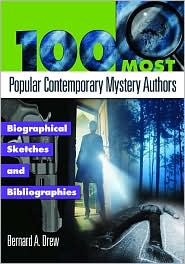The hundred choices, all of whom write in English and were living at the time of the book’s preparation, are about evenly divided between men and women. They are generally an excellent selection. The absence of several major figures—Walter Mosley (whose name is consistently misspelled Moseley), Mary Higgins Clark, Elmore Leonard, P.D. James, Sara Paretsky, Ruth Rendell—is accounted for by their presence in other volumes in the publisher’s popular author series. While the same is probably true of an especially surprising omission, Michael Connelly, I suspect Simon Brett and Robert Barnard, certainly more important and probably more popular than many of the writers included, have fallen through the cracks.
Each entry includes a feature-article-style biography and career summary, heavily reliant on secondary sources, a list of fiction books by series (a continuing character being an apparent requirement for inclusion), and a list of sources of further information, including print and online sources. Black-and-white passport-size head shots illustrate many of the entries.
As a few examples will show, this is among the all-too-plentiful reference sources harmed by excessive errors and inconsistency of coverage. Listings of books contributed to range from seemingly exhaustive (Bill Crider, Lawrence Block) to annoyingly sparse (Joe Lansdale, Bill Pronzini). Carolyn Hart’s Secrets is not a contributed-to anthology but a single-author short story collection. The entry for Laurie King should note that The Art of Detection belongs to both the Mary Russell/Sherlock Holmes and Kate Martinelli series. Though some tabloid sensations are noted (e.g. Rita Mae Brown’s relationship with Martina Navratilova), the Anne Perry entry, while giving her real name of Juliet Hulme, says nothing about her involvement as defendant in a New Zealand murder case—or indeed that she ever lived in New Zealand. The Donald Bain entry makes no reference to his widely known ghostwriting of Margaret Truman’s mystery novels. Of Max Allan Collins’ posthumous collaborations with Mickey Spillane, listed here as Mike Hammer novels, Dead Street does not include Hammer, and King of the Weeds was apparently retitled Kiss Her Goodbye and not published until 2011. Jack Webb’s The Badge, referenced in the James Ellroy entry, is not a novel but a nonfiction work. And finally, in the Carole Nelson Douglas entry, Drew has listed at least one pure phantom: Probable Cause (1993), a collection of four novellas about a fictitious California law firm written by Douglas, Carolyn Banks, William Bernhardt, and yours truly—it would have been fun, but alas, it was never published or even written.
While this might be a passable inclusion for a small public or school library reference collection, there’s little to interest the serious fan or scholar. The secondary bibliographies are the most useful feature, but they are very spotty in their scope, rarely including material from genre-specific publications like Mystery Scene or The Armchair Detective.



